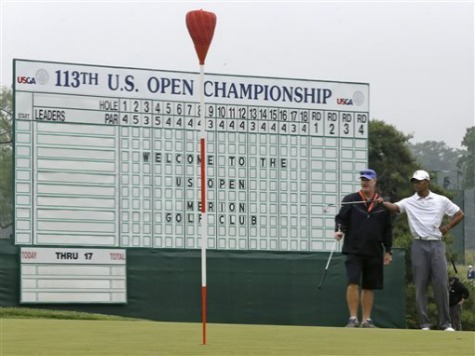(AP) Threatening weather halts play at US Open
ARDMORE, Pa.
Play has been halted at the U.S. Open because of threatening weather in the area.
Officials blew the horn at 8:36 a.m. Thursday, less than 2 hours after the start of the first round.
Heavy storms were forecast for the Philadelphia area for most of the day, expecting to further soak a Merion course that had already received 6 1/2 inches of rain in the past week.
THIS IS A BREAKING NEWS UPDATE. Check back soon for further information. AP’s earlier story is below.
Phil Mickelson rolled a birdie attempt 8 feet past the hole at No. 11. Steve Stricker did the same at No. 12. Bogey. Bogey.
Even with all the rain softening up the shortest major championship course in nine years _ with the promise of more storms to come _ Merion was going to be no easy stroll for the world’s top golfers. The notoriously sloping greens lived up to their reputation as play began Thursday morning at the U.S. Open.
The skies were cloudy and a breeze rustled the trees when Cliff Kresge, a Floridian ranked No. 551 in the world, hit the first tee shot of the opening round, the first of 156 players on the historic course hosting the Open for the first time in 32 years.
The marquee group was scheduled to tee off shortly after lunchtime. Tiger Woods, Rory McIlroy and Adam Scott are together as the top three players in the world rankings, although a forecast calling for severe storms in the afternoon could delay or interrupt their round.
Mickelson’s early tee time presented a logistical challenge. He arrived at Merion after an overnight flight from San Diego, where he watched his oldest daughter graduate from the eighth grade.
Early on, he played like someone who didn’t get much sleep. Starting on the 11th hole _ one of the unorthodox arrangements in the setup at this course _ he opened with a 3-putt for a bogey and put his tee shot in the rough at No. 12. But he saved par at the 12th and birdied the short par-3 13th to pull back to even par.
Sergio Garcia was greeted with mild applause and a few audible boos when he was introduced at the start of his round. Garcia is playing his first tournament in the U.S. since his recent exchanges with Tiger Woods, which hit a low point when Garcia said he would serve fried chicken if Woods came over for dinner during the Open. Garcia has since apologized for the remark, and he was noticeably friendly to the gallery during Wednesday’s practice round, stopping several times to sign autographs.
For all the extraordinary effort it took to shoehorn a modern-day championship onto the historic but intimate course, there was nothing anyone could do about the 6 1/2 inches of rain that has soaked the Philadelphia area during the last week. Sunny days Tuesday and Wednesday helped dry out things a bit, but one look at the radar Thursday morning indicated that stormy skies would return in a matter of hours.
The various forecasts led to a USGA news conference Wednesday that covered topics like hail, standing water and the dreaded “potentially damaging winds.” At one point during a long and otherwise straight-laced opening statement, USGA vice president Tom O’Toole spoke about the presentation of the championship trophy _ then rolled his eyes skyward and added: “which we hope will be Sunday.”
The forecast also renewed calls for officials to break with U.S. Open tradition and allow players to lift, clean and replace balls in the fairway if the conditions get nasty.
Nice try. But such protestations went nowhere fast.
Any major disruption would be a shame, given that the U.S. Open has waited 32 years to return to the course where Olin Dutra overcame a serious stomach illness to win in 1934, where Ben Hogan hit the picture-perfect 1-iron approach to No. 18 before winning in a playoff in 1950, where Lee Trevino pulled a rubber snake out of his bag at the first hole of the playoff when he beat Jack Nicklaus for the title in 1971, and where David Graham became the first Australian to win the trophy in 1981.
It would also dampen the drama of Woods’ pursuit of his first major in five years, a reasonable proposition given that he’s already won four times on the PGA Tour this year. And Scott’s hopes of becoming the first to win the Masters and U.S. Open back-to-back since Woods in 2002.
Thought to be too small to host an Open anymore, Merion had been off the radar for so long that many of the top names in the field _ including Woods _ had never played it until recently. Organizers had to be creative with the placement of hospitality tents and parking lots on the club’s relatively small footprint, and ticket sales were capped at 25,000 a day instead of the usual 40,000 or so for recent championships.
But it still was expected to provide a quality test, emphasizing precision over power in the first major championship since Shinnecock Hills in 2004 on a course under 7,000 yards.

COMMENTS
Please let us know if you're having issues with commenting.